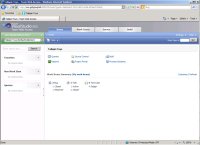Inside TFS
Introducing Team Web Access for TFS 2010
Mickey Gousset offers an introduction to the new Team Web Access console for Team Foundation Server 2010.
Most systems now-a-days come with both a thick-client component, which provides access to all the functionality of a product, and a Web component, which provides access to a subset of functionality. Team Foundation Server (TFS) 2010 is no different.
Back when TFS 2005 shipped, there was no built-in Web equivalent to Team Explorer, the thick client used for accessing TFS functionality. However, there was a product called TeamPlain, which was a third-party product built specifically to provide browser-based access to TFS. Ultimately, the TeamPlain product was acquired by Microsoft, and integrated directly into TFS. In TFS 2010, this Web-based console is known as Team Web Access.
Team Web Access, by default, is installed on the application tier machines of your TFS installation. For organizations that have restrictions for what products can be installed on a user's desktop, or for users who just don't want another application on their machine, Team Web Access can make a good alternative to Team Explorer. It also works with most modern browsers, including Internet Explorer, Firefox, and Safari. One thing to keep in mind: to use Team Web Access, each user must have a Client Access License (CAL) for TFS 2010.
To open Team Web Access, open a web browser and you use the standard URL for your TFS, but add web to the end. For example: http://win-gs9gmujits8:8080/tfs/web. This will open Team Web Access, as shown in Figure 1.

[Click on image for larger view.] |
| Figure 1. Team Web Access. |
Team Web Access provides the following functionality to end users
- Create/Edit Work Items and Work Item Queries
- Create/Edit Areas and Iterations for Work Items
- Read-only access to Version Control
- Access to Team Build
- A Work Item Only View, which doesn't require a Client Access License
Let's look at each of these areas in a bit more detail.
Work Items, Areas and Iterations
Working with work items using Team Web Access is almost exactly the same as using Team Explorer. You have access to all the same work item queries, both personal and team queries. When you open a work item, the form appears the same as it does in Team Explorer. You can create new work items, edit existing work items, create new work item queries, and edit existing queries.
The work item experience with Team Web Access also provides two unique features not available with Team Explorer. The first is the ability to perform a full text work item search. This allows you to search the body of a work item for key words. The second is the ability for Team Web Access to automatically generate a work item state diagram for a particular work item type. This allows you to see and understand the different states and transitions available for the work item.
Using Team Web Access, you also have the ability to edit the Areas and Iterations for your work items, which is an important part of keeping work items organized.
Version Control
Team Web Access provides you read-only access to Team Foundation Version Control. You can view files and even download the latest versions of them. You can also compare two files, view version history, as well as view annotation information about a file, showing who made what changes in the file. You also have the ability to find and view Shelveset information. You cannot, however, check information into or out of Team Foundation Version Control.
Team Build
Team Web Access allows you access to Team Build. While you can't create new build definitions, you can queue a build to run, manage your build qualities, as well as view completed and queued build information.
Work Item Only View of Team Web Access
The work item only view of Team Web Access can be used to create and view work items that are assigned to you in TFS, without having to have a client access license (CAL) for TFS. The work item only view only allows you to perform the previous functions listed.
To access the work item only view, a user must be assigned to the Work Item Only View Users group for the Team Foundation Server that hosts the team project collections and the team projects that need to be accessed. Access to the Work Item Only View is provided using the same URL for Team Web Access. A user's membership in the Work Item Only View Users security group is used to determine what functionality they have access to.
About the Author
Mickey Gousset spends his days as a principal consultant for Infront Consulting Group. Gousset is lead author of "Professional Application Lifecycle Management with Visual Studio 2012" (Wrox, 2012) and frequents the speaker circuit singing the praises of ALM and DevOps. He also blogs at ALM Rocks!. Gousset is one of the original Team System/ALM MVPs and has held the award since 2005.